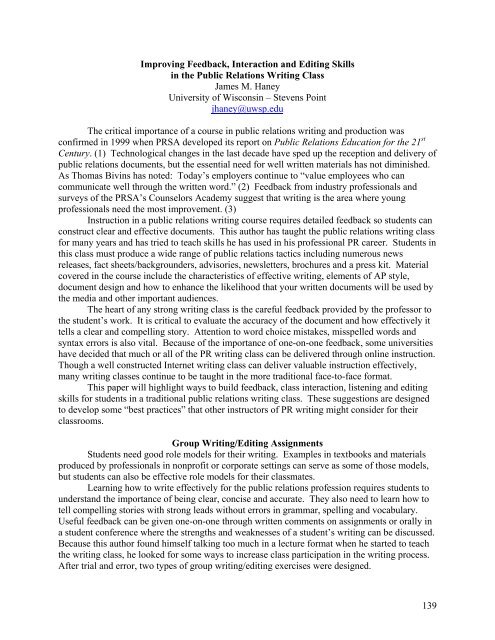2008 PROCEEDINGS - Public Relations Society of America
2008 PROCEEDINGS - Public Relations Society of America
2008 PROCEEDINGS - Public Relations Society of America
You also want an ePaper? Increase the reach of your titles
YUMPU automatically turns print PDFs into web optimized ePapers that Google loves.
Improving Feedback, Interaction and Editing Skills<br />
in the <strong>Public</strong> <strong>Relations</strong> Writing Class<br />
James M. Haney<br />
University <strong>of</strong> Wisconsin – Stevens Point<br />
jhaney@uwsp.edu<br />
The critical importance <strong>of</strong> a course in public relations writing and production was<br />
confirmed in 1999 when PRSA developed its report on <strong>Public</strong> <strong>Relations</strong> Education for the 21 st<br />
Century. (1) Technological changes in the last decade have sped up the reception and delivery <strong>of</strong><br />
public relations documents, but the essential need for well written materials has not diminished.<br />
As Thomas Bivins has noted: Today’s employers continue to “value employees who can<br />
communicate well through the written word.” (2) Feedback from industry pr<strong>of</strong>essionals and<br />
surveys <strong>of</strong> the PRSA’s Counselors Academy suggest that writing is the area where young<br />
pr<strong>of</strong>essionals need the most improvement. (3)<br />
Instruction in a public relations writing course requires detailed feedback so students can<br />
construct clear and effective documents. This author has taught the public relations writing class<br />
for many years and has tried to teach skills he has used in his pr<strong>of</strong>essional PR career. Students in<br />
this class must produce a wide range <strong>of</strong> public relations tactics including numerous news<br />
releases, fact sheets/backgrounders, advisories, newsletters, brochures and a press kit. Material<br />
covered in the course include the characteristics <strong>of</strong> effective writing, elements <strong>of</strong> AP style,<br />
document design and how to enhance the likelihood that your written documents will be used by<br />
the media and other important audiences.<br />
The heart <strong>of</strong> any strong writing class is the careful feedback provided by the pr<strong>of</strong>essor to<br />
the student’s work. It is critical to evaluate the accuracy <strong>of</strong> the document and how effectively it<br />
tells a clear and compelling story. Attention to word choice mistakes, misspelled words and<br />
syntax errors is also vital. Because <strong>of</strong> the importance <strong>of</strong> one-on-one feedback, some universities<br />
have decided that much or all <strong>of</strong> the PR writing class can be delivered through online instruction.<br />
Though a well constructed Internet writing class can deliver valuable instruction effectively,<br />
many writing classes continue to be taught in the more traditional face-to-face format.<br />
This paper will highlight ways to build feedback, class interaction, listening and editing<br />
skills for students in a traditional public relations writing class. These suggestions are designed<br />
to develop some “best practices” that other instructors <strong>of</strong> PR writing might consider for their<br />
classrooms.<br />
Group Writing/Editing Assignments<br />
Students need good role models for their writing. Examples in textbooks and materials<br />
produced by pr<strong>of</strong>essionals in nonpr<strong>of</strong>it or corporate settings can serve as some <strong>of</strong> those models,<br />
but students can also be effective role models for their classmates.<br />
Learning how to write effectively for the public relations pr<strong>of</strong>ession requires students to<br />
understand the importance <strong>of</strong> being clear, concise and accurate. They also need to learn how to<br />
tell compelling stories with strong leads without errors in grammar, spelling and vocabulary.<br />
Useful feedback can be given one-on-one through written comments on assignments or orally in<br />
a student conference where the strengths and weaknesses <strong>of</strong> a student’s writing can be discussed.<br />
Because this author found himself talking too much in a lecture format when he started to teach<br />
the writing class, he looked for some ways to increase class participation in the writing process.<br />
After trial and error, two types <strong>of</strong> group writing/editing exercises were designed.<br />
139
















